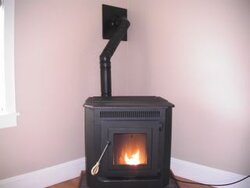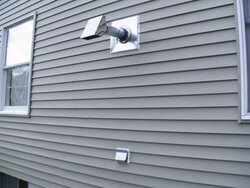After $2800 for the stove, $750 worth of pipe and $500 for installation (not to mention $1000 worth of pellets) I've now got a room full of smoke.
My St.Croix Hastings that I ordered in July was finally installed on 11/7. While the installer was here we fired up the stove, noticed a small amount of smoke leakage, applied some sealant to the leaks and everything looked good. We let the stove burn for about 30 minutes after reaching full-run mode. I left it burning for about another half hour after he left and everything seemed OK.
Since my inspection wasn't until Monday (11/10) I shut the stove down and waited until I passed the inspection with the town building inspector. The inspection passed so when I got home tonight I topped off the hopper and started up the stove--hoping to finally be buring pellets instead of oil this winter. As I started to see sparks and a small flame in the firebox I started smelling smoke. I looked up and there was smoke pouring out of the vertical joints in the pipe (Duravent). At the back of the stove there's a 5' vertical pipe, a 1' adjustable pipe, a 90, a 45 and then a 5' run out the wall thimble to the chimney. I turned off the stove immediately, which killed the exhaust fan and left smoke pouring out the intake damper vent and out the bottom of the front door. I checked the cleaning rods and the ash pan and all were closed up. I finally decided to open the door, take out the burn grate and drop all of the smoldering pellets into the ash pan and get them out of the house.
So I have two questions....
Did I do the right thing by turning off the stove with smoke coming into the house? It never completed the startup cycle so I couldn't shut it down properly to allow the stove to vent itself out.
Is it normal for the pipe sealer to shrink after installation and allow smoke out again? Or is Duravent crap and I should go back to my dealer and ask them to get me something else? I purchased the stove from Royal Fireside in Uxbridge, MA and was generally happy with them Their installer is a subcontractor for them and seems like he knows what he's doing. I just hope he's able to remedy this quickly.
Thanks,
Steve
My St.Croix Hastings that I ordered in July was finally installed on 11/7. While the installer was here we fired up the stove, noticed a small amount of smoke leakage, applied some sealant to the leaks and everything looked good. We let the stove burn for about 30 minutes after reaching full-run mode. I left it burning for about another half hour after he left and everything seemed OK.
Since my inspection wasn't until Monday (11/10) I shut the stove down and waited until I passed the inspection with the town building inspector. The inspection passed so when I got home tonight I topped off the hopper and started up the stove--hoping to finally be buring pellets instead of oil this winter. As I started to see sparks and a small flame in the firebox I started smelling smoke. I looked up and there was smoke pouring out of the vertical joints in the pipe (Duravent). At the back of the stove there's a 5' vertical pipe, a 1' adjustable pipe, a 90, a 45 and then a 5' run out the wall thimble to the chimney. I turned off the stove immediately, which killed the exhaust fan and left smoke pouring out the intake damper vent and out the bottom of the front door. I checked the cleaning rods and the ash pan and all were closed up. I finally decided to open the door, take out the burn grate and drop all of the smoldering pellets into the ash pan and get them out of the house.
So I have two questions....
Did I do the right thing by turning off the stove with smoke coming into the house? It never completed the startup cycle so I couldn't shut it down properly to allow the stove to vent itself out.
Is it normal for the pipe sealer to shrink after installation and allow smoke out again? Or is Duravent crap and I should go back to my dealer and ask them to get me something else? I purchased the stove from Royal Fireside in Uxbridge, MA and was generally happy with them Their installer is a subcontractor for them and seems like he knows what he's doing. I just hope he's able to remedy this quickly.
Thanks,
Steve


 .
.




 hh: :gulp: :ahhh:
hh: :gulp: :ahhh: